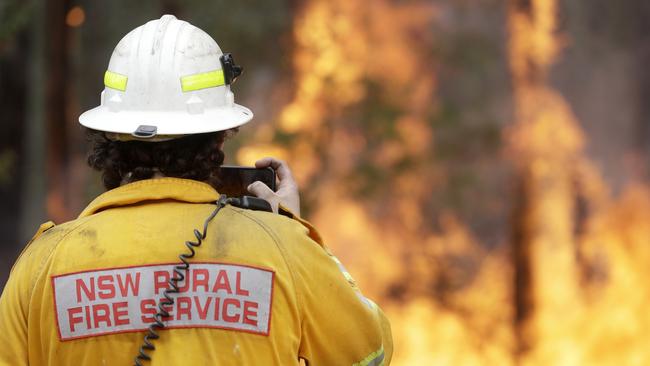Ideology won’t help anyone get through bushfire crisis

That hasn’t stopped green advocates and the gullible from immediately linking them to Australia’s “inaction on climate change”. Climate experts as far afield as Sydney Lord Mayor Clover Moore and Swedish truant schoolgirl Greta Thunberg agree on the connection.
A coalition of retired fire chiefs, in what seems a closing-the-stable-door defence, claimed that last April it “knew that a bushfire crisis was coming” and nagged the government to invest in more resources. But, “fundamentally, (the government) doesn’t like talking about climate change”.
The ex-chiefs referred to being under an “unofficial gag order”, whatever that means, and argued that if governments had listened, there would have been more assets deployed and fewer fires.
When Australia accounts for just 1.3 per cent of global emissions that proposition is plainly absurd.
Yet, for all the bluster, the only mention of climate change in five years of Fire and Rescue NSW annual reports is a reference to crews being encouraged to turn off all non-essential lights during Earth Hour, “joining millions of people worldwide in showing their commitment to tackling climate change’’.
For five years the Victorian Country Fire Authority didn’t mention climate change. Its priorities were “fairness” and “inclusion”, which it mentions 56 times.
Well may former fire chiefs blame climate change, but if they were so convinced of the connection between wildfires and global warming, why didn’t they publicly campaign for immediate, practical steps to reduce fuel loads in national parks? Surely they could have pushed their rural colleagues, government ministers, and department heads harder?
Victoria publishes limited data, but a planned hazard reduction of 370 hectares in East Gippsland was reduced to nine after protesters claimed it was “killing baby birds alive”. Much of East Gippsland is now a wasteland.
These days, it’s commonplace for national park entries to be blocked by boulders or chains and padlocks. Many fire trails are so overgrown that a sign identifying them is all that distinguishes them from the rest of the forest.
Against the advice of local brigades, the green firefighting hierarchy supported a wind farm amid prime agricultural land, rendering an existing airstrip unsuitable for water bombers. Aerial bombing is considered 40 per cent of the firefighting effort.
While Aborigines are free to clear their land without a permit, once it transfers to non-indigenous owners those rights are forfeited. There are heavy penalties, including jail, for those who clear their property without permission. Green tape and delays abound. Fires have destroyed some properties held up in this process.
So now the chickens are coming home to roost, with eastern Australian bushfires consuming an area approaching five million hectares. They have inflicted an unspeakable toll on human life, property, wildlife and livestock.
As weather patterns slowly return to normal and the fires are extinguished, there will be yet another government inquiry.
More money will be demanded, along with calls for additional jet tankers, even though there are few airfields from which they can operate. Money is needed, but alone it is not the answer. Much of it goes to the deskbound. For example, in the four years up to 2019, the NSW Rural Fire Service received a 78 per cent boost in funding, yet it oversaw a decline in volunteers and fire trucks.
Of course for Hollywood and other propagandists, it is vital that inaction on climate change, not inaction on hazard reduction, be the focus. For them, this link is vital to their cause.
Proving that a prophet can be any fool from home, The New York Times screams “Australia is committing climate suicide”. In an article long on drama and short on facts, the newspaper intones that “the response of Australia’s leaders (to the fires) has not been to defend their country but to defend the fossil industry”. Talk about ignorance and warped values.
Better to deprive 200 million Indians of a light globe and throw them crumbs through a UN-administered climate fund than provide economic independence through Australian coal.
Like ancient Druids, the media left, Hollywood and the rest of the global warming cult won’t hear that Australia spends 11 times the global average on renewable power and invests in renewables at a rate per capita four to five times faster than China, the EU, Japan and the US. They give no credit to Australia for being on track to meet its Paris Agreement target for 2030, despite a 2.2 million jump in population since 2013.
To fanatics, facts don’t matter. That there has been no drying trend in 100 years of Australian data, and that science is yet to establish a causal link between climate change and drought is irrelevant.
While weather, droughts and bushfires will, from time to time, continue to feature, population growth and encroachment on green spaces increase risks. Indeed, 87 per cent of bushfires are due to humans. Only 6 per cent are naturally started. Arsonists, attracted by the ease of ignition, perhaps start more than half. To date, 183 arsonists have been arrested. However, while those delegated to manage the environment and those charged with property protection share a close ideological relationship, little will change.
At some point, government must take control. Communication and co-operation between the different jurisdictions, departments and agencies must be better co-ordinated.
Priorities must be set, audited and enforced. The insurance industry should be given a louder voice. It’s an important financial stakeholder and risk assessor. This crisis will lead to higher premiums, more uninsured properties and serious moral dilemmas next time.
For now, courageous frontline firefighters are putting their lives on the line and fighting fires the scale of which owes much to green ideology and confused and fragmented leadership. It is hoped that an inquiry will establish clear priorities and directions that will be followed.



After decades of poor housekeeping, Australia’s latest devastating bushfires were predictable. Politicians and serving officials want to leave post mortems until the fires are out. Their instincts are correct.